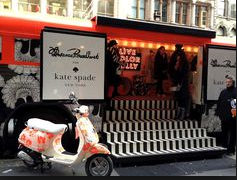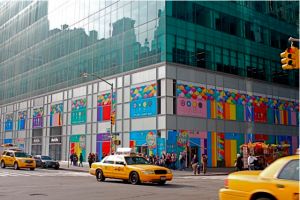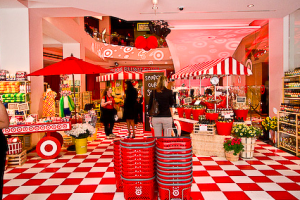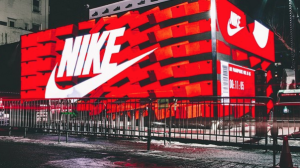A marketing trend that is now a marketing strategy for advertisers and brand managers to build brand equity is pop up retailing. The shop that purposefully springs up and disappears quick. These shops are intended to be open for a few days up to a year and may or may not offer products for purchase (Kim, et al. 2010). Pop up shops are experiential marketing tactics that promote a brand or product line, in a short time frame and usually in spaces that allow for communication between consumer and brand reps (Kim, et al. 2010). Many people like going to pop up shops to gain the interaction with brand reps and gain their expert knowledge (Kim et al. 2010). The pop up shop is appealing to consumers due to the marketing environment (Hayes, 2014). It provides consumers with new diverse experiences (Hayes, 2004).
Kate Spade Pop Up in NYC
Dylan’s Candy in NYC
Inside a Target Pop Up in NYC
Nike Pop Up – Featuring the launch of SNKRS app in NYC
This marketing trend started early 2000’s with companies such as Target being the first to spring a pop up shop in Manhattan’s Tribeca neighborhood filling a town house with merchandise from the store (Hays, 2004). Customers could use the wares and place orders with Target employees accompanying the merchandise. The marketing tool gave consumers a sense of Target’s sensibility and offered an experience they wouldn’t have had in the store. A year later Target took a temporary home in a large boat at Pier 62 on the Hudson River in NYC offering customers varying choices of selected products. Any products they liked, could be picked up at warehouse near the pier (Hays, 2004). Fall of 2003, Target’s temporary residency was in the Rockefeller Center advertising the beginning of Isaac Mizrahi’s new clothing line sold at Target. Target has also used pop up shops to provide awareness to breast cancer and offer specific product lines before holiday seasons (Hays, 2004). Besides the enhanced shopping experience, pop up shops also are perfect opportunities to attract media attention. The unique innovative shopping experience provides desirable and memorable experiences that give pop up retailing a good reputation. According to Trenwatching.com in 2004 pop up stores became all the rage with companies such as Louis Vuitton, Gap, Levi’s Jeans, Marc Jacobs and so many more claiming temporary residencies all over the world. New York city is a popular place for brands to utilize this marketing tactic. It has become popular to see the brands you favor offer their products in unique marketing environments such as Gap utilizing a 1960’s school bus that became a traveling pop up with appearances at beaches, summer festivals in major cities like Los Angeles and New York (Kim et al. 2010).
Pop up stores have been springing up all around the world offering consumers with product awareness, interactive experiences, brand uniqueness, exclusivity and exciting shopping experiences (Kim, et. al., 2010). The experiential marketing tactic came about due to declining revenue in mass media advertisements (Zarantonello, 2013). Traditional communication platforms were re-evaluated and alternative platforms became of interest. These alternative platforms were a way for companies to establish brand equity (Zarantonello, 2013). The pop up store created an innovative shopping space where the consumer felt the exclusivity of the brand and product line and was engaged in a different shopping experience (Kim, et. al., 2010). The experience was new, unique and involved the consumer to have an effect on the product line. Pop up shops are intended to build media attention, generate revenue, test the consumer market or retail location (Kim, et. al., 2010). This temporary location has offered many business owners opportunities to commit to a short term lease versus a five year lease commitment (Gregory, 2009). Many online businesses use this tool as a way to get some offline visibility. These pop-up shops are becoming more and more creative in marketing environments ranging from store installations to traveling motor vans. Currently, with digital and social media platforms as means to engage audiences and attract a larger audience pop up shops provide compelling content. You may be able to see the benefits in pop up retailing by a hike in sales but you can also take note of the number of impressions your post receives on social media platforms.
How effective are these pop up shops and do they truly engage the consumer and improve branding?
A study was conducted on consumer psychographic characteristics that effect behavioral beliefs towards experiential marketing such as pop up retailing (Kim et al. 2010). The study concluded that consumers possessing the need for innovativeness and enjoyment while shopping exhibited positive attitudes towards pop up retailing, perceiving it to be interesting, good, pleasant and appealing (Kim et al. 2010). Pop up retail should aim at building long-term consumer relationship, that result in growing emotional attachment to the a brand or product line (Kim et al. 2010). Pop up retailing needs to be highly authentic and in experiential environments that focus on brand attributes, the launch of new products and enables dialogue with brand reps. (Kim et al. 2010). These are key elements attracting people to the experience and why it has evolved from a trend to a marketing strategy for major corporations today.
References:
“Pop-up Retail” Trendwatching.com Retrieved from: http://trendwatching.com/trends/POPUP_RETAIL.htm
Pop Up Stores Become More Than Just A Trend. Retail Touch Points. Retrieved from: http://www.retailtouchpoints.com/features/special-reports/pop-up-stores-become-more-than-just-a-trend
Zarantonello, L. (2013) The Impact of Event Marketing on Brand Equity. International Journal of Advertising. (32) 2. 225.
Kim, H., Flore, A., Hiehm, L., and Jeong, M. (2010). Psychographic Characteristics affecting behavioral intentions towards pop-up retail. International Journal of Retail & DistrbutionMangement. (38) 2. 133- 154.
Hays, C. (December, 2004). Stores that Pop Up and Go Away on Purpose. The New York Times. Retrieved from: http://www.nytimes.com/2004/12/07/business/businessspecial/stores-that-pop-up-and-go-away-on-purpose.html?_r=0
Gregory, Sean (November, 2009). Why Pop Up Shops are Hot. Time Magazine. Retrieved from: http://content.time.com/time/magazine/article/0,9171,1940675,00.html





7 Responses to Is That a Pop Up, Wait Where Did It Go?